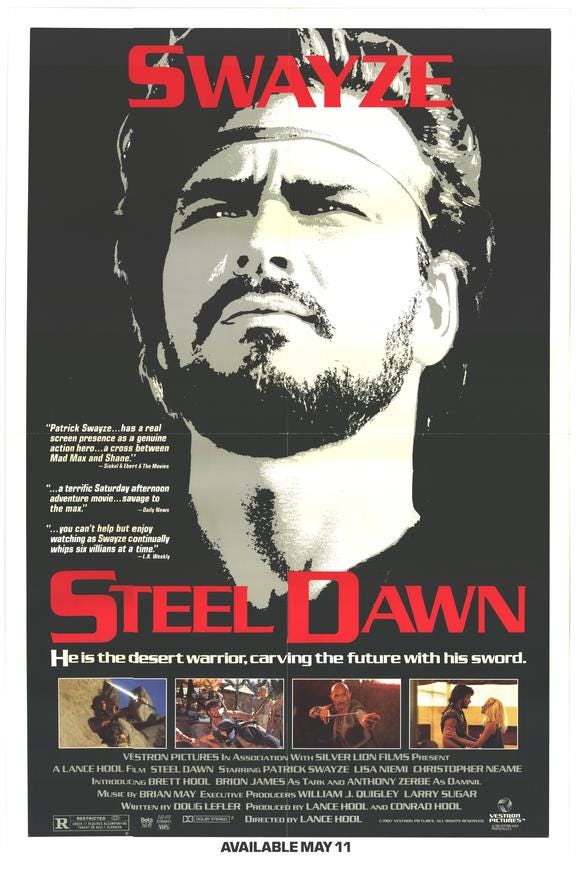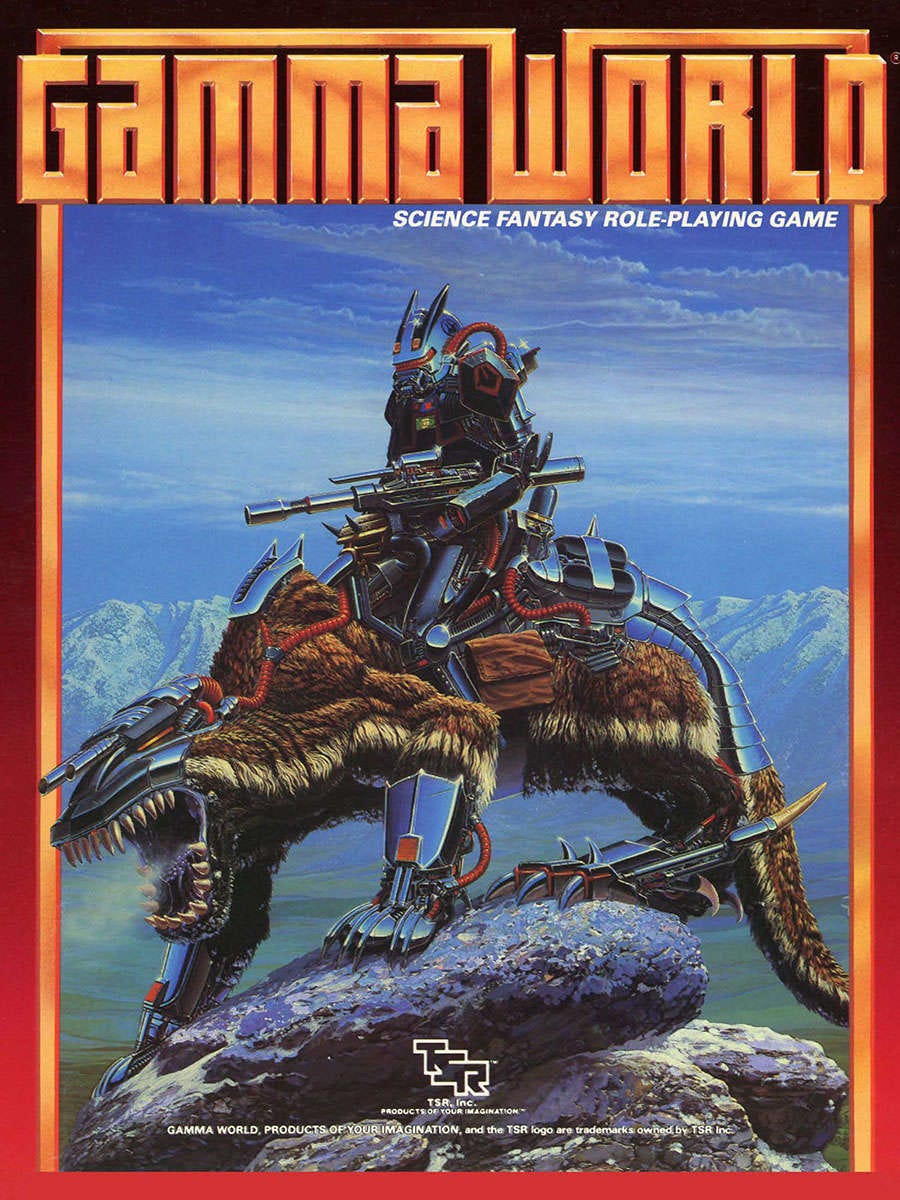Retro-Review: Steel Dawn (1987)
Between yesterday’s post discussing the thoughts I had after revisiting the most recent Conan film (2012) and my friend
’s post about the release of a remake of the movie Deathstalker (which I’ll be watching and reviewing this weekend), my mind has been contemplating the Sword & Sorcery movies I used to watch with my Opa on Sunday afternoons. Sure, we watched a lot of other genre films, but the ones that seem to stick with me the most are the Sword & Sorcery films and the more I think about them the more I realize how spoiled modern viewers are for quality fantasy films and television shows. Rewatching older Sword & Sorcery films is a reminder that the filmic experience of young fantasy fans in any era prior to the 2000s was the cinematic viewing equivalent of walking uphill (both ways) to and from school in 12 feet of snow…and loving it.The 70s, 80s, and 90s were the heyday of low budget Sword & Sorcery fare and all the fantasy of the era often overlapped with a Post-Apocalyptic narrative. From movies to video games to role playing games to fantasy novels there was an explosion of Post-Apocalyptic entertainment available. Books like Sword of Shannara, with its animatronic monster, and television shows like Thundarr the Barbarian immediately spring to mind.
One the movie front, there was quite a variety in quality to choose from. Mad Max, The Road Warrior, and The Quiet Earth were some of the shining stars of the Post-Apocalyptic genre. Zardoz and Tank Girl were two of the weirder and less coherent entries. Jean Claude Van Damme’s Cyborg fell somewhere in the middle of entertaining and mind-numbingly horrible. My personal favorite Post-Apocalyptic film lies somewhere between Logan’s Run, Escape from New York, and The Planet of the Apes. It also adds a little Western film and Sword & Sorcery spice to the mix.
On the gaming front, the post-apocalyptic role playing games varied from the systemically complex Aftermath to the wildly imaginative Gamma World. Aftermath always seemed to me to be a simulation of “what would happen if,” which meant that most characters die in horrible fashion -- at least they did after some complex mathematical equations were applied to a couple of die rolls. They didn’t call it “After Math” for nothing. Twilight 2000 was a representation of “what was going to happen.” T2000, like Aftermath, featured complex rules systems with realistic representations of radiation poisoning. Nothing more fun that calculating “rads” and their very real affects on your character. Gamma World was a pure “what if” that included everything from serious speculation to mutant plant/rabbit fusions. Gamma World was the most intriguing of the games, but it also had the disadvantage of multiple editions with incompatible rules sets. I would be remiss if I left out the ultra-enjoyable Car Wars game by Steve Jackson Games...cars with machine guns and rocket launchers...mmm...fun.
As for video games...Wasteland is one of the classic computer role playing games and the ancestor of the excellent Fallout series of games.
In the middle of this Cold War inspired Post-Apocalyptomania, in 1987, came a film starring one of Hollywood’s biggest stars. Fresh out of successful films like Red Dawn (itself a Post-Apocalyptic movie in its own way), Youngblood, and Dirty Dancing, Patrick Swayze entered the genre with an film that fused narrative elements from the Post Apocalyptic, Western, Sword & Sorcery, and Planetary Romance genres.
Steel Dawn was directed by Lance Hool (Missing in Action 2) with a screenplay by Doug Lefler (director of The Last Legion). In addition to Swayze, the film stars Lisa Niemi (Swayze’s real world wife) in the “romantic” role of Kasha, b-movie stalwart Brion James as Tark “the romantic rival,” Anthony Zerbe as the scene chewing villain Damnil, future Mummy Arnold Vosloo as Makker, and Christopher Neame as the corrupted swordsman Sho.
The outline of the story is essentially Shane. A wanderer comes to town and helps a family who is being pressured by a land baron to give up their water and lose their farm. Like most adaptations of Shane, the film understates the dangerous nature of the wanderer and overstates the relationship between Shane and the mother of the family under siege. Alan Ladd’s Shane is too friendly, the book’s character is more akin to the Jack Palance character and Jack Shaefer makes it clear that he is a killer who is tired of having his life defined by his skill with a gun. Jean Claude Van Damme’s Shane clone in Nowhere to Run encounters a single mother who can more easily become the romantic interest than the mother in Ladd’s film. She’s not a romantic option in the book at all as the boy of that version comes to see the steadfast strength of his own father as superior to that of the wandering killer. Clint Eastwood’s Shane translation (Pale Rider) is the Hand of God working vengeance against an unjust man. In Steel Dawn, Swayze’s Shane is a former soldier who wanders into town with the goal of, temporarily at least, taking the place of a “Peacekeeper” who is murdered at the beginning of the film.
Swayze’s arrival throws a wrench into the plans of the land baron, and into a burgeoning romance between Tark and Kasha. His skills with a sword spark the imagination of Kasha’s son Jux and he uses those skills to challenge the local land baron and avenge the death of the prior “Peacekeeper.”
The swordplay, use of meditation, and moral clarity of the hero echo the narrative tropes of Planetary Romance. The inclusion, at the beginning of the film, of weird horror in the form of sand-dwelling mutants, the aforementioned swordplay, and the lone walker nature of Swayze’s character fall nicely in the Sword & Sorcery genre. The setting is definitely Post-Apocalyptic with a nuclear blasted landscape with enough history that their have even been Post-Holocaust wars that resulted in the creation of Post Apocalyptic super swordsman like Swayze and Sho -- the warrior hired by the land baron to defeat Swayze. And the story is a pure translation of Shane, but it completely lacks Shane’s adulation of the father figure.
I have always found it interesting that the father, who is so strong in Schaefer’s book Shane, is emasculated in favor of the Shane figure in film representations of the tale. Shane is a dangerous man, a gambler and murderer akin to Doc Holliday. Shane is a villain who becomes a hero when he encounters the civilizing influence of a loving family headed by equals. There is no doubt that the parents in Schaefer’s knowledge are equals in leadership and in temperment. The combination of the scene where Shane and the father demolish a tree stump with the mother’s pie baking is intentional, right down to the line “that’s the best bit of stump I’ve ever tasted.”
Had Shane stopped in town, instead of the farm, he would have quickly become the villain of the story. He would have been hired by the land baron and been lethal in his work. A key scene, in most representations, demonstrating the difference in focus from father worship to rogue worship is the scene where the father gets into a fight in the local tavern. The book makes it clear how powerful the father is and how he is holding back to save his son, the movies make no such concessions and Steel Dawn is no different. Tark is not the young boy’s father, but he is a capable farmhand who has been in the father role for some time. He is quickly displaced by Swayze, even when he is a fairly competent defender in his own right -- he’s just not a sword jedi who meditates while standing on his head like Swayze.
The film is enjoyable, though very campy, and it is largely due to Swayze’s extraordinary charisma.




